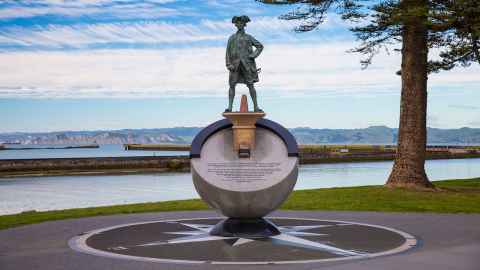To dethrone statues erases presence, not past
18 June 2020
Opinion: Despite strong instincts to preserve the past, Felicity Barnes explains why she won't be sad to see monuments to our colonial legacy removed.

Historians, naturally enough, have a soft spot for old things. Indeed, we are often to be found fighting lonely rearguard actions to save ancient files that government institutions no longer deem worthy, or volumes that libraries now find surplus to requirements.
We can find meaning in what others see as detritus and new stories in old books: that’s our super power. It’s no surprise, then, that our first instinct is to save what is threatened.
So when it comes to statues, it’s also not surprising that some would like to see them kept, or at least carted to the safe remove of a museum or some other mausoleum to memory. The argument goes that, however inappropriate they are now, the statues function as portals back into another place and time, capturing in bronze or stone the zeitgeist of days gone by. Removing them simply erases the complicated past they represent.
Maybe. But museums are more than places to store inconvenient pasts, and they are already pretty short on display space. And this historian for one, is not convinced that Marmaduke Nixon, or Sir George Grey, should take up much more historical space than they already have. If it is no longer right to have them on a public pedestal – which is the literal function of statues – then perhaps we should not grant them the dignity of a display case.
If it is no longer right to have them on a public pedestal – which is the literal function of statues – then perhaps we should not grant them the dignity of a display case.
Some have argued that these statues could be recontextualised, given some explanatory plaques, then used as cumbersome cultural conversation starters. I am unsure why objects that give offence to many should be given such a role in the first place. But, in any case, this position overlooks an obvious fact. Having stood for years in public places, most of these statues and the history they represent have been ignored. As resting places for pigeons they are unbeatable: as ways to kickstart broader public engagement with the past they have been failures.
Having taught Aotearoa New Zealand history to undergraduates for around a decade, I have yet to have any student come up to me and say, “That statue of George Grey in Albert Park has really got me thinking about our colonial past.” And, of course, that was never their intention. Statues of Grey and others exist to memorialise a particular version of the past, a version that is now being challenged. History has changed around them, not through them: it is only by being in the wrong place in the wrong time that they have become part of a public debate, not because of their own intrinsic historical value.
We should of course be concerned about the loss of our material culture. Heritage conservation has hardly been New Zealand’s strong suit. But the fact that these particular statues are now in danger of being swept away because of new historical awareness may be all the assurance we need that they are not essential to understanding our past.
Although humanities studies remain the poor cousins of our university system, academic historians and their colleagues outside the ivory towers continue to produce rich and vibrant historical studies. Without the work of scholars like James Belich, Judith Binney, Aroha Harris, Nepia Mahuika, Vincent O’Malley, Keith Sinclair and others, that complicated past embodied in statues would indeed be obscure. But we have it, not only in in books and articles, but in museums, in whakapapa, in films, novels, poetry, and art. Removing the statues erases their presence but not their past.
It seems to me that we owe ourselves – not the statues – a considered and careful reappraisal of our public memorials. Taking a measured and inclusive approach might itself make a useful contrast with the circumstances around some statues. But though it militates against every fibre of my packrat historical being, I will not be sad to see some legacies of our colonial past calmly dethroned.
Dr Felicity Barnes is a senior lecturer in history from the Faculty of Arts.
This article reflects the opinion of the author and not necessarily the views of the University of Auckland.
Used with permission from Newsroom A crisis of public spaces 17 June 2020.
Media queries
Alison Sims | Research Communications Editor
DDI 09 923 4953
Mob 021 249 0089
Email alison.sims@auckland.ac.nz